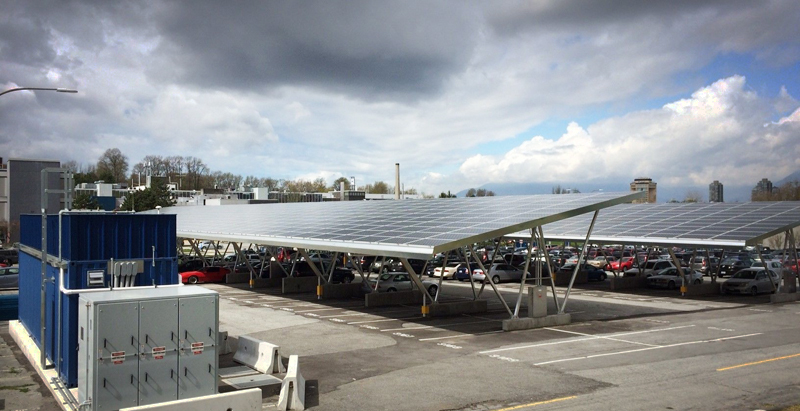Setting the Scene for Innovative Eco Solutions
Located on the scenic west coast of Canada, the British Columbia Institute of Technology (BCIT) is a public polytechnic institution of higher education. Its five campuses sprawl across the Metro Vancouver region with the main campus located in Burnaby, British Columbia.
A forward thinking institution that believes in a hands-on approach to learning, BCIT wanted to develop a renewable energy system that would have a real impact on clean transportation and incorporate innovative solar components.
The Roots of Success
It all began in early 2007, when BC Hydro, a Canadian electric utility, and SMART, a BCIT Applied Research Group, embarked on a joint research initiative to design and develop Canada's first Smart Power Microgrid at BCIT's Burnaby campus. The goal was to build a smarter, more secure power grid that would balance power generation to demand, reduce the potential for blackouts, and integrate current energy sources.
Titled the Smart Microgrid Program, the ongoing initiative includes BCIT’s Energy OASIS (Open Access to Sustainable Intermittent Sources) project involving a network of fast and standard charging stations that allow electric cars to be charged in minutes – facilitating the transition to green transportation in Canada.
Making it Happen
To make the Energy Oasis a reality, Panasonic Eco Solutions Canada was chosen to design and construct the integrated system of parking canopy structures, canopy mounted solar panels, and energy storage system.
Panasonic got to work engineering, procuring, and constructing the two parking canopies with 250 kW of solar PV – enough to power the EV charging stations. The team also designed and installed a 500 kWh energy storage and energy management system utilizing Panasonic lithium-ion batteries and a bidirectional inverter. The Panasonic Battery Energy Storage System (BESS) communicates with a Distributed Energy Management System, which learns when to buy, sell or store energy using intelligent algorithms and sends the requests to store or discharge the BESS at key times, such as peak usage or in low utility rate hours.
Collaborating with BCIT and other industry partners, Panasonic integrated the solar and battery systems into BCIT’s microgrid for a comprehensive, innovative structure.
Lasting Achievement
Recognized with a Canadian Solar Industries Association (CanSIA) Game Changer Award, the project was the first of its kind in Canada to successfully demonstrate the integration of solar power, energy storage, and electric vehicle charging stations in a grid-tied or ‘islanded’ configuration. With the team’s commissioning and post implementation support services, BCIT can count on reliable startup and continuous operation for years to come.
To learn more about Panasonic Eco Solutions and our work in North America, please visit www.panasonic.com/energysolutions.
Related Stories
| Nov 10, 2011
Suffolk Construction awarded MBTA transit facility and streetscape project
The 21,000-sf project will feature construction of a cable-stayed pedestrian bridge over Ocean Avenue, an elevated plaza deck above Wonderland MBTA Station, a central plaza, and an at-grade pedestrian crossing over Revere Beach Boulevard
| Apr 13, 2011
Duke University parking garage driven to LEED certification
People parking their cars inside the new Research Drive garage at Duke University are making history—they’re utilizing the country’s first freestanding LEED-certified parking structure.
| Mar 2, 2011
Cities of the sky
According to The Wall Street Journal, the Silk Road of the future—from Dubai to Chongqing to Honduras—is taking shape in urban developments based on airport hubs. Welcome to the world of the 'aerotropolis.'
| Feb 15, 2011
Iconic TWA terminal may reopen as a boutique hotel
The Port Authority of New York and New Jersey hopes to squeeze a hotel with about 150 rooms in the space between the old TWA terminal and the new JetBlue building. The old TWA terminal would serve as an entry to the hotel and hotel lobby, which would also contain restaurants and shops.
| Dec 17, 2010
Subway entrance designed to exude Hollywood charm
The Hollywood/Vine Metro portal and public plaza in Los Angeles provides an entrance to the Red Line subway and the W Hollywood Hotel. Local architect Rios Clementi Hale Studio designed the portal and plaza to flow with the landmark theaters and plazas that surround it.
| Nov 2, 2010
Wind Power, Windy City-style
Building-integrated wind turbines lend a futuristic look to a parking structure in Chicago’s trendy River North neighborhood. Only time will tell how much power the wind devices will generate.
















